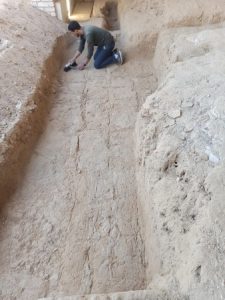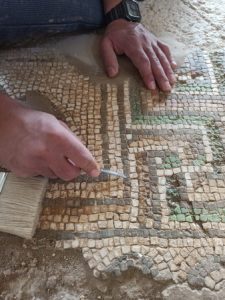
Iwan Center for Cultural Heritage, Engineering Faculty, at IUG has launched the urgent restoration project of “Absan” mosaic floor in “Absan Alkabira” town, in partnership with Absan Alkabira municipality and the Ministry of Tourism and Antiquities, funded by Prince Claus Fund for Protecting Cultural Heritage in Danger Areas.
Dr. Ahmed Alastal, Director of Iwan Center, explained that the project aimed to strengthen the protection of the archaeological site and prevent damage caused by abandonment and closure. The project also aimed to conserve the Absan mosaic floor, as well as to promote and outreach the site to the community by reopening it to visitors from all over Gaza Strip.

The phases of the project, according to Dr. Ayman Hassouna, technical supervisor of the site’s restoration work, are as follows: cleaning of the mosaic floor surroundings, removing soil and dirt, reconstructing the mud fence surrounding the floor, conservating and restoring mosaic pieces following globally applicable scientific approaches and principles.
Dr. Hassouna stressed that the project team is comprised of several specialists and experienced individuals who have previously participated in archaeological restoration and mosaic conservation projects.
According to Dr. Hassouna, this archaeological site has a high archaeological value because it contains a Byzantine mosaic floor from the local Byzantine mosaic school in southern Palestine. The mosaic floor is similar to the floors of Mukheitim Church, Saint Hillaion church, and the ones of Aslan and Deir Albalah.
Dr. Ayman Hassouna mentioned that this site was the home of one of the saints in the Byzantine era, who, when died, was buried in the house, and mosaics were built around it. It was then turned into a shrine, and during the Ottoman era, one of the righteous (Sheikh Ibrahim) was buried next to him, making it a sacred place for Muslims as well. It was named (the shrine of Sheikh Ibrahim), and it still is. On the northern side of the site, there is a small open area with Islamic and Byzantine graves.

Eng. Mahmoud Albalawi, the project’s official, pointed out that the project fits into the center’s strategy for preserving archaeological sites in the Gaza Strip after the center’s ongoing success in restoring historical buildings. Abandonment of the site resulted in many damages, the most significant of which are; the site’s absence from generations’ memories and lack of community awareness, the cracks in the mosaic floor and its layers’ separation that leave a thick layer of dust on top, cracks in archaeological stones that embrace the mosaic floor, the cracks in ancient gravestones, and thick grass growing around them.
Eng. Albalawi explained that the project would promote the site’s sustainability and the upkeep of the mosaic floor through restoration and damage removal. It would also be accomplished by documenting, producing, and disseminating the first official map, raising community awareness, promoting the site, and increasing visitor numbers through interactive awareness-raising activities with the community. The site’s sustainability and upkeep can also be done by developing the capacity of many archaeologists and architects to restore and document the mosaics, as well as the involvement of various community groups in maintaining the site and enhancing its protection.

